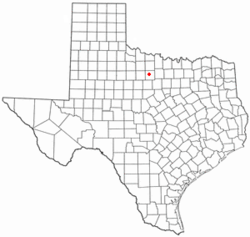Newcastle, Texas
Newcastle, Texas | |
|---|---|
 Downtown Newcastle. | |
 Location of Newcastle, Texas | |
 | |
| Coordinates: 33°11′45″N 98°44′56″W / 33.19583°N 98.74889°W | |
| Country | United States |
| State | Texas |
| County | Young |
| Area | |
• Total | 1.80 sq mi (4.67 km2) |
| • Land | 1.79 sq mi (4.64 km2) |
| • Water | 0.01 sq mi (0.03 km2) |
| Elevation | 1,125 ft (343 m) |
| Population (2020) | |
• Total | 526 |
| • Density | 290/sq mi (110/km2) |
| Time zone | UTC-6 (Central (CST)) |
| • Summer (DST) | UTC-5 (CDT) |
| ZIP code | 76372 |
| Area code | 940 |
| FIPS code | 48-50868[3] |
| GNIS feature ID | 2411242[2] |
Newcastle is a city in Young County, Texas, United States. Following the beginning of coal mining in 1908, the town was established and named after the English coal town, Newcastle upon Tyne. Coal mining had ended by 1942. Its population was 526 at the 2020 census.[4][5][6]
Geography
[edit]According to the United States Census Bureau, the city has a total area of 1.8 sq mi (4.7 km2), all land.
Demographics
[edit]| Census | Pop. | Note | %± |
|---|---|---|---|
| 1920 | 1,452 | — | |
| 1930 | 1,157 | −20.3% | |
| 1940 | 1,044 | −9.8% | |
| 1950 | 743 | −28.8% | |
| 1960 | 617 | −17.0% | |
| 1970 | 624 | 1.1% | |
| 1980 | 688 | 10.3% | |
| 1990 | 505 | −26.6% | |
| 2000 | 575 | 13.9% | |
| 2010 | 585 | 1.7% | |
| 2020 | 526 | −10.1% | |
| U.S. Decennial Census[7] | |||
| Race | Number | Percentage |
|---|---|---|
| White (NH) | 423 | 80.42% |
| Black or African American (NH) | 3 | 0.57% |
| Native American or Alaska Native (NH) | 2 | 0.38% |
| Some Other Race (NH) | 1 | 0.19% |
| Mixed/Multi-Racial (NH) | 29 | 5.51% |
| Hispanic or Latino | 68 | 12.93% |
| Total | 526 |
2020 census
[edit]As of the 2020 United States census, there were 526 people, 246 households, and 147 families residing in the city.
2000 census
[edit]As of the census[3] of 2000, 575 people, 233 households, and 157 families resided in the city. The population density was 317.5 inhabitants per square mile (122.6/km2). The 266 housing units averaged 146.9 per square mile (56.7/km2). The racial makeup of the city was 93.91% White, 1.39% African American, 1.04% Native American, 2.26% from other races, and 1.39% from two or more races. Hispanics or Latinos of any race were 5.57% of the population.
Of the 233 households, 31.3% had children under the age of 18 living with them, 50.2% were married couples living together, 12.9% had a female householder with no husband present, and 32.6% were not families. About 28.3% of all households were made up of individuals, and 15.0% had someone living alone who was 65 years of age or older. The average household size was 2.47 and the average family size was 3.03.
In the city, the age distribution was 26.4% under 18, 7.0% from 18 to 24, 28.9% from 25 to 44, 21.7% from 45 to 64, and 16.0% who were 65 or older. The median age was 37 years. For every 100 females, there were 99.0 males. For every 100 females age 18 and over, there were 90.5 males.
The median income for a household in the city was $24,485, and for a family was $27,500. Males had a median income of $28,125 versus $20,417 for females. The per capita income for the city was $15,004. About 16.1% of families and 18.1% of the population were below the poverty line, including 24.6% of those under age 18 and 4.2% of those age 65 or over.
Education
[edit]The City of Newcastle is served by the Newcastle Independent School District.
Infrastructure
[edit]Newcastle Volunteer Fire Department services the community.[citation needed]
References
[edit]- ^ "2019 U.S. Gazetteer Files". United States Census Bureau. Retrieved August 7, 2020.
- ^ a b U.S. Geological Survey Geographic Names Information System: Newcastle, Texas
- ^ a b "U.S. Census website". United States Census Bureau. Retrieved January 31, 2008.
- ^ "Brian Hart, "Joseph Alexander Kemp"". Texas State Historical Association online. Retrieved April 15, 2013.
- ^ "J. W. Williams, "Kell, Frank"". The Handbook of Texas. Retrieved April 16, 2013.
- ^ a b "Explore Census Data". data.census.gov. Retrieved May 21, 2022.
- ^ "Census of Population and Housing". Census.gov. Retrieved June 4, 2015.
- ^ https://www.census.gov/ [not specific enough to verify]
- ^ "About the Hispanic Population and its Origin". www.census.gov. Retrieved May 18, 2022.
External links
[edit]- Newcastle, Texas from the Handbook of Texas Online


 French
French Deutsch
Deutsch